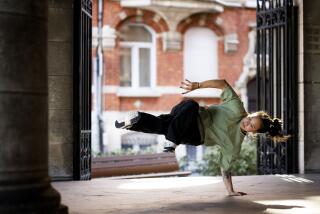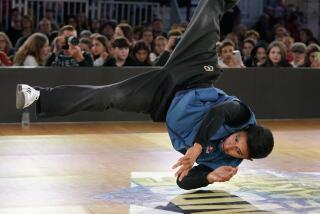Smash Hit
- Share via
Sixteen feathers from the left wing of a goose are used to make the best badminton shuttle. They are bound with string and glue and attached to a piece of cork. During the birdie’s brief life, it will arc gracefully in the air in deep baseline shots, be gently caressed in deft net shots, and smashed violently until its feathers litter the court like confetti.
Annihilating birdies is Ronald Sou’s specialty. He springs into the air with the muscle-bound legs of a weightlifter, racket cocked behind his head like a tomahawk. He strikes a shuttle in a vicious jump-smash, and it sounds like the blast from an air rifle.
Seventeen-year-old Sou will represent the U.S. in men’s doubles at the International Badminton Federation World Championships to be held Aug. 15-21 at the Arrowhead Pond of Anaheim. It marks the first time the world championships will be held on U.S. soil, presenting a prime opportunity for indifferent Americans to put aside their biases and see badminton as Asians see it. Jumping, lunging, running and split-second reactions--not to mention smashes that can reach more than 200 mph--make badminton a brutally exhausting sport that suffers no sissy stigma in Asia, where countries such as China, Korea, Malaysia and Indonesia dominate the sport. To brawny types who beg to differ, instructor Alex Liang suggests stepping onto the court: “Five minutes, everybody die.”
The San Gabriel Valley Badminton Club in El Monte is the brainchild of Eric McMullin, a Scotch American who saw a business opportunity catering to a niche demographic that knows and loves badminton. Of his 900 members, nearly all are Asian. Inside this bare industrial compound, they find both a family-oriented activity and a highly competitive sport most Americans think is something you play at a backyard barbecue with a beer in one hand.
Like the mythological phoenix, the badminton birdie died only to be reborn with different feathers. Flash back to 1940, when a ballroom on the Santa Monica Pier was converted to badminton courts to meet public demand and badminton was a popular form of recreation for the film industry. The Manhattan Beach Badminton Club, erected in 1936, harks back to the popularity of the sport among that set. It boasts the tarnished trophies, vintage photographs and air of understated poshness one expects from a country club, but of its 250 members, only about half now actually play the sport. Badminton went into steady decline after World War II, and in 1982 the NCAA declined to govern the sport, effectively rendering scholarship opportunities nil.
During the last decade, Asian immigrants have revitalized Southern California’s badminton scene, crowding public courts across Los Angeles. “This is the worst I’ve ever seen it,” says Bob Cook, World Masters Games champion in the 55-60 age bracket and executive secretary of the Pan American Badminton Confederation. “I’ve never in my life had a problem securing court space night after night.”
According to Cook, about 5,000 club-level badminton players populate Greater Los Angeles, playing in Manhattan Beach and El Monte at the county’s two private clubs and at a host of public facilities sponsored by city Parks & Recreation departments. (For a list of local facilities, visit the Southern California Badminton Assn. at www.scbabadminton.org.)
Much of the recent surge in popularity has been attributed to Filipino Americans returning from trips to the island nation with tales of badminton courts opening in every neighborhood, complete with Gatorade-bearing waitresses.
“It’s a fast sport that has everything going for it,” says Lee Calvert, national champion in the--brace yourself--80-and-over women’s category. The honorary member of the Manhattan Beach Badminton Club credits her shapely figure to a lifetime of badminton. And unlike tennis, it’s something that a person with rudimentary coordination can start enjoying right away, says McMullin.
While the Asian community’s badminton influence is apparent, the land of freedom and individuality has given foreign-born players a new perspective on the game they grew up with. Joohyun Lee says the rigors of training for the South Korean national team killed her love of the sport, a love she recaptured when she came to the U.S. two years ago. “My culture and my parents pressured me to be a good player and get a gold medal or something,” says the instructor at the San Gabriel Valley club. “I practiced really hard, but I wasn’t happy.” Liang, who left school at 15 to train on the Chinese national team, explains: “If you want to be the best player, you have to concentrate on only one thing. You don’t have a life.”
Olympic gold or copious ESPN coverage would certainly help boost the sport here. But to be embraced as fully as it has recently been in the Philippines, it needs to be seen as a sport that’s as physically satisfying as it is socially gratifying.
Until that day comes--if it ever does--Southern Californians can content themselves with watching the upcoming world championships in Anaheim. After all, you can do that with a beer in one hand.
More to Read
Go beyond the scoreboard
Get the latest on L.A.'s teams in the daily Sports Report newsletter.
You may occasionally receive promotional content from the Los Angeles Times.










